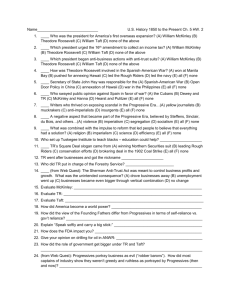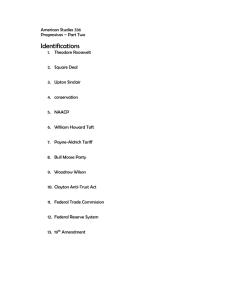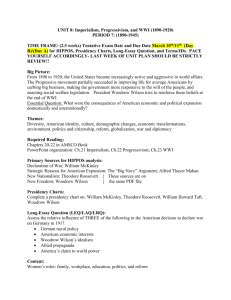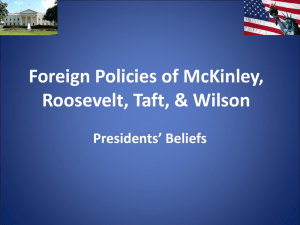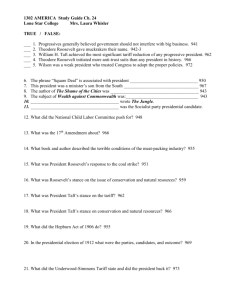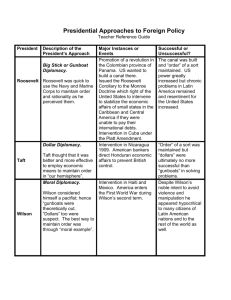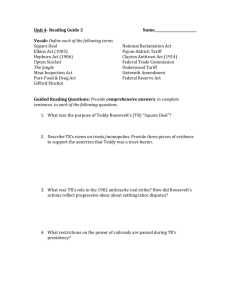10th American History - Waverly
advertisement
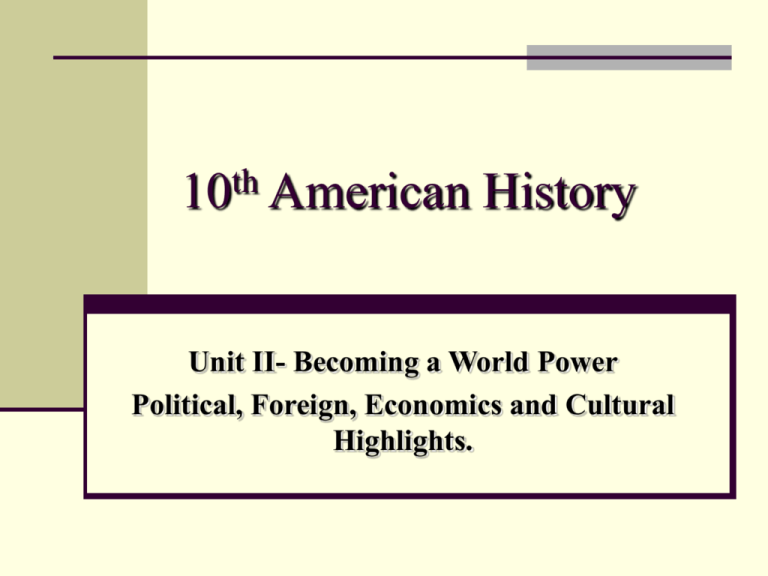
10th American History Unit II- Becoming a World Power Political, Foreign, Economics and Cultural Highlights. William McKinley (Republican) 1897-1901 25nd President Election of 1896 Free Silver- Major issue Democratic-Populist Candidate- William Jennings Bryant v. McKinley (Republican) William Jennings Bryant Single issue- Free Silver Excellent orator- “Cross of Gold Speech” Appealed to Westerns but not labor or city people Would run for President twice more- never wins. McKinley Very few Speeches- in favor of “Sound Money” Carried the Urban-Industrial states Would be assassinated. Leon Czolgosz - Assassin •Leon Czolgosz, (pronounced SHOLGUS),the son of Polish-Russian immigrants, was born in Detroit, Michigan, in 1873 •In 1901, Czolgosz moved to Buffalo, New York, site of the Pan American Exposition. There, in a receiving line on September 6, he shot President McKinley two times. Although surrounded by fifty bodyguards, Czolgosz was able to walk up to McKinley and fire two shots at him. Hit in the chest and abdomen, McKinley shouted out "Be easy with him, boys" as secret service agents beat Czolgosz with fists and pistol butts. •Czolgosz--who gave his name to police as Fred Nieman, or Fred Nobody--later stated in reference to his decision to assassinate McKinley, "I didn't believe one man should have so much service, and another man have none." After a brief trial, Czolgosz was convicted. He was executed on October 29, 1901. Before being executed on 20th October, 1901, Czolgosz remarked that: "I killed the President because he was the enemy of the good people - the good working people. I am not sorry for my crime." Theodore Roosevelt 1901-1909- 26th President (Republican) McKinley’s Death Rough Riders and San Juan Hill Square Deal Food and Drug Act 1906 Newlands Reclamation Act 1902 Theodore Roosevelt William Howard Taft 1909-1913- 27th President (Republican) Election of 1912 Taft- 45 indictments against trusts; civil service jobs; million acres to national reserves; protected mineral rights; postal saving banks, 2 new states, 16th amendment (income tax); Dept. of Commerce and Dept. of Labor. Roosevelt- Good and bad trusts, Issues, Progressives (Bull Moose) and New Nationalism Wilson- Issues and New Freedom Debs- Socialist Outcome of Election Woodrow Wilson 1913-1921- 28th President (Democrat) Leadership Federal Reserve Act 1913 Clayton Anti-Trust Act 1914 Federal Trade Commission Act 1914 World War I President Warren G. Harding 29th President 1921-1923 - Republican Post WW I Fears and Headaches- bombs, Return to “Normalcy” Bolsheviks (Red Scare), riots and labor strikes. Foreign Affairs No League of Nations Washington Conference- Five Power Treaty, Nine-Power Treaty, and Four Power Treaty- Disarmament Domestic Affairs- Return to Normalcy Harding Scandals - The “Ohio Gang” Charles Forbes- Head of Veterans Bureau Jesse Smith- Aide in Justice Department Thomas Miller- Alien Property Custodian Albert Fall- Sec. of the Interior and “Teapot Dome” Death of Harding- sudden death while still president President Calvin Coolidge 30th President - 1923-1929 Republican Government and Business- Freedom of business from governmental rules and regulations. “Laissezfaire”. Large businesses were allowed to be created. Country prospered and the Supreme Court favored business over labor. “The man who builds a factory, builds a temple and the man who works there, worships there.” Farm Problem- “Farmers have never made money,” he said,”I don’t believe we can do much about it.” “Silent Cal” “The business of America is business” Imperialism Economic reasons- international trade and need for raw materials from Asia, Africa and Latin America Military reasons- to defend their shores and protect their trade interests Ideology 1- Nationalism- enhancing a nation’s power and prestige. 2- Cultural superiority- Social Darwinists believed in this. Social responsibility to “civilize” less developed countries. Imperialism Manifest Destiny- expand westward to the Pacific, and beyond the shoreline Hawaii- trade, sugar, bayonet constitution and annexation China- trade, Treaty of Wanghia 1844- gave U.S. most favored nation status, Sphere’s of Influence, Open-Door Policy and Boxer Rebellion Japan- trade, Commodore Matthew Perry, and the Treaty of Kanagawa. Spanish American War Cuban Unrest Yellow Journalism Reasons Maine Explosion- “Remember the Maine” De Lome Letter U.S. Sugar interests U.S. sympathy to the rebel cause and the evil Spanish Jingoes (Hawks) and the pressure on President McKinley Outcome Teller Amendment on Cuban Independence and Rough Riders and San Juan Hill U.S. receives Cuba, Puerto Rico, Guam and Philippines in exchange it gives Spain $20 million. U.S. now has over seas territories, bases for trade and navy. Annexation of Philippines and three years of revolution. (Independence in 1946) Anti-Imperialist League 1898- imperialism is a violation of the foundation of American self government. Platt Amendment- Cuba (Guantanamo, Protectorate); Foraker Act 1900- Puerto Rico. T.R. Roosevelt, Taft and Wilson Roosevelt and Latin America Walk softly and carry a big stick Great White fleet Helping Panama to get independence Building the Panama Canal Roosevelt Corollary to the Monroe Doctrine Taft’s Dollar Diplomacy Wilson’s Moral Diplomacy Rejection of dollar diplomacy Use of persuasion and American ideals to advance the nation’s interest abroad. Wilson and the Mexican Revolution Promoting American interests in other countries Using economic power to achieve American policy goals. President Wilson would not recognize the de facto government of Gen. Huerta Wilson used armed force against Mexico in Veracruz and against Poncho Villa Rise of tariffs U.S. and the Panama Canal U.S. interest in the Canal Offering Columbia $10 million and $250,000 annually. Rejected Panama’s revolution against Columbia Building the Canal World War I “M.A.I.N.E.”- European causes for the war. U.S. neutrality Reasons for the U.S. entrance into the war. America in World War I America in Post World War I Wilson’s fourteen points Treaty of Versailles League of Nations Impact of World War I st 1 Red Scare Communist revolution in Russia- 1917 and the rise of the Bolsheviks Fear of the “Reds”- communists who promoted the violent overthrow of the U.S. government. U.S. Communist parties formed Bombings- through the mail. Palmer raids – deportation and incarceration. Lingering Effects of World War I War Debts owed to the U.S. $10 Billion owed by Allies to U.S. Fordney-McCumber Tariff made repayment hard. Reparation payments by Germany Washington Naval Conference- 4 Power, 5 Power and 9 Power treaties. Agreement to cut back on size of navies Avoid competition for China Ending the Arms Race and establishing Peace? Kellogg-Briand Pact- high ideals- Peace signed by 60 nations. But no system of enforcement, just a promise. Progressivism Square Deal and Theodore Roosevelt Regulating Big Business- Sherman Anti-Trust and Trust Busting 16th Amendment - 1913 Taft and the Payne-Aldrich Tariff- supposed to lower tariffs actually raised them Wilson’s New Freedom Tariff reform Banking reform- Federal Reserve System Anti-Trust Laws- Clayton Anti-Trust Act What is the Federal Reserve? It manages the countries money system; regulates the banking system; is a bankers bank; and is the government’s bank. Imperialism Why? Economic, Military and Ideology Manifest Destiny Hawaii- trade, sugar, bayonet constitution and annexation China- trade, Treaty of Wanghia 1844- gave U.S. most favored nation status, Sphere’s of Influence, OpenDoor Policy and Boxer Rebellion Japan- trade, Commodore Matthew Perry, and the Treaty of Kanagawa. Spanish American War- Cuba, Philippines, Guam and Puerto Rico. Panama Canal Taft’s Dollar Diplomacy World War I Financial ties to the Allies Unrestricted submarine warfare Homefront Mobilizing the economy- industry, food, fuel and supplies Mobilizing workers- National War Labor Board, Women, Paying for the War- Taxes and Liberty Bonds (war bonds) Economic Impact on US and the World Post World War I Labor Strife- difficulties, labor losses and major strikes. New Economic Era Henry Ford, the Assembly line and worker pay. The effect on industry: competition, productivity, and welfare capitalism. The New Consume: new products, advertising and demand, installment paying and credit. Weaknesses: many Americans were suffering after WWI- farmers, overproduction, low prices, farm failures, insects, floods, hurricane, etc, brought economic depression to many parts of the nation. Harding and Coolidge Harding Cut federal budget and reduced taxes on wealthy (trickle down). Fordney-McCumber Tariff- high tariff, foreign products went up, American prices went up- hurt farmers and Europeans. Teapot Dome Scandal- Bribes from Oil companies to drill for oil in federal oil reserve. Coolidge “Business of America is business” Business would help America grow, promote the arts and sciences and fund the charities. Limited role of government in business. Lowered taxes and reduced the budget. Weakened federal regulations on business. War Debt- Europe owed the U.S. over $10 billion, but too war torn and tariffs to high, force Germany to pay more reparations. U.S. become world’s banker. 1920’s The role of women- work outside the home during WWI. Economic boom of the 20’s provided jobs for women. Urbanization Hard times in agriculture saw people move to cities to get work. Rise of the automobile Increase in eduation Industrial growth means rise in earnings Gross Domestic Product- between 1922-1928 grew 30% Growth of the automobile industry Corporate profits up, unemployment down, welfare capitalism, and the ability to purchase new products and services Stock Market expansionFalse Sense of Security 1920’s Weaknesses Wealth Distribution Credit on the Stock Market- buying on margin Federal Reserve System Stock Market Crash Black Thursday, Black Monday, Black Tuesday GDP dropped almost in 1/2 Effects of the crash- Individuals, Banks (over 5,000 closed), Business and World Economy. Immigration History 1800-1910 New Immigrants Old Immigrants- 1800-1880- Northern and Western Europe New Immigrants- 1880-1910- Southern and Eastern Europe as well as Japanese and Chinese. Why did they come?- Economic, Political and Religious. Ellis Island and Angel Island. Prejudice against immigrants Urban American Life Different Classes- Wealthy, middle class and working class. Tenements and Settlement Houses Political Scandal and Reform City Government- Scandal and Reform Political Machines and Machine Bosses Tammany Hall in New York- Boss Tweed Credit Mobilier Scandal and President Grant President Arthur and Civil Service Reform Farmer’s Reform Movement Late 1800’s crop prices falling, farm debt rising, costs rising; a need for farmers to organize. Order of the Patron’s of Husbandry- National Grange 1887- Interstate Commerce Act. Populist Party- coalition of farmers, labor leaders and reformers. Silver v. Gold issue Segregation and Discrimination Jim Crow Laws and Lynching Plessy v. Ferguson (1896) = separate but equal. Booker T. Washington W.E.B. Du Bois and the N.A.A.C.P. Other groups who face discrimination 1) Hispanic Americans 2) Asian Americans 3) Native Americans Progressivism Reforming Society Progressives- reform movement Muckrakers Housing reforms Civil rights Workplace National Child Labor Limiting women’s workday Minimum Wage laws. Courts and Labor Laws 1905 - “Lochner v. New York”- supreme court did not allow 10 hour workday for bakers 1908 - “Muller v. Oregon”- Supreme Court upheld law guaranting 10 hour workday for women. “Bunting v. Oregon”- 10 hour workday for men in mills and factories. The Triangle Shirtwaist fire Unions- Industrial Workers of the World- unskilled Reforming Government City government- Commision system, Council-Manager system. State Government- Electoral reforms, commissions on railroads, utilities, transportation, civil service and taxation 17th Amendment- direct election of Senators. Initiative, Referendom and \Recall. Opportunities for Women Education Employment Children’s Health and Welfare Prohibition WCTU- Women’s Christian Temperance Union. Carrie Nation 18th Amendment 18th Amendment- Prohibition Civil Rights- campaigning against poverty, segregation, lynchings and Jim Crowe Laws Women’s Suffrage and Anti-Suffrage arguments Reform- Late 1800’s and early 1900’s Children’s health and welfare Prohibition Civil Rights and black women Women’s Suffrage Trust Busting and regulating big business Consumer Protection Environmental conservation 19th Amendment- 1920 Civil Rights under Roosevelt, Taft and Wilson- Brownsville Incident. Imperialism Cultural superiority over the under-developed (backward) nations. Social Darwinism- brother’s keeper, social responsibility to “civilize” the less developed. Desire to bring Christianity, western style culture and democracy to other (backward) peoples. T.R. Roosevelt’s Square Deal Coal Strike of 1902 and TR threatens to send in the troops Each person to get a square deal no more, no less. Limiting power of trusts, promote public health and safety and improve working conditions. Trust Busting and Regulating the Railroads. Protecting Consumers- Muckrakers, Meat Inspection Act, and Pure Food and Drug Act. Environmental Conservation Presidents’ Taft and Wilson William H. Taft Created Dept. of Labor 16th Amendment- Income Tax Wilson- New Freedom Tariff, Banking, and Anti-Trust Reform Women Gain the right to vote- 19th Amendment Imperialism Hawaii Sugar interests- Sanford B. Dole Bayonet constitution King Kalakaua and Queen Liliuokalani Annexation Spanish-American War Yellow Journalism Jingoism Philippines, annexation and rebellion Roosevelt and Rough Riders Anti-Imperialists Spanish-American War Homefront in World War I Mobilizing the Economy Regulating Industry Regulating Food Regulating Fuel Supplying the troops Mobilizing Workers National War Labor Board Women’s war efforts African American movement and employment Influenza Epidemic (Pandemic) Winning American support Committee on Public Information Propaganda Anti-German Feeling and American Patriotism Limiting Antiwar Speech Schenck v. United States (1919)- Supreme court limits freedom of speech. Post War Havoc 1918-1919 Pandemic- world wide influenza epidemic- killed 10 times more Americans than did WWI. 1st Red Scare- rise of Bolsheviks, communism, fear, bombs, Palmer raids and deportation. Labor Problems- Workers unhappy after WWI, Unions lost members and political power, and there were major strikes. Limiting Immigration Competition for jobs after WWI, and the Red scare caused anti-immigration feelings. Nativists- mostly Protestant Christians and Labor leaders targeted new immigrants and asked for immigration restrictions. Immigration control- National Origins Act, Nativism, KKK revival (native white supremacy) Sacco and Vanzetti- Italian immigrants, anarchists, tried for murder or political ideas? New Economic Era- 1920’s Henry Ford- revolutionizes industry Assembly line Effect on Industry competition helped the automobile industry grow. Other industries learned- assembly line, productivity went up. Welfare Capitalism- companies provide benefits to employees to promote worker satisfaction and loyalty. Effect on Society Demand is up for all types of products. Boom in midwestern cities Cities grew and so did suburbs- transportation Tourist industry grew. New Economic Era- 1920’s New Consumer- New Products for the home Electricity Radio connected the world Public transportation, and passenger airlines. Advertising created a deman New ways of paying- credit and installment buying. Weakness of Economy Many American suffered during the 20’s Farmers- demand was low, competition from Europe high, farm failures, debt, tariff, and nature- weather and insects. The Nation desires to return to Normalcy American Life Changes- 1920’s New Roles for Women Opportunities New Family Roles The Flapper Effects of Urbanization Conflicts over Values Fundamentalism Scopes Trial- Teaching of Evolution and Creation Science- Bryan and Darrow Prohibition- 18th Amendment Organized crime- like Al Capone Bootleggers Speakeasies Harlem Renaissance African Americans during and after WWI W.E.B. Du Bois and Marcus Garvey Renaissance of art in Harlem- writer, poets, artists, musicians and performers. A New Popular Culture is born- 1920’s Mass Entertainment Radio Movies Era of Heroes Film Stars- Charlie Chaplin, Rudolph Valentino, Clara Bow, Mary Pickford, and Douglas Fairbanks. Charles A. Lindbergh- transatlantic flight. Amelia Earhart- 1st women across the Atlantic, was lost trying to fly around the world. Sports Heroes- Ruth, Grange, Wills, Jones, etc. Arts of the 1920’s- F. Scott Fitzgerald, Sinclair Lewis, Edna St. Vincent Millay, Hemmingway, George Gershwin (music)
